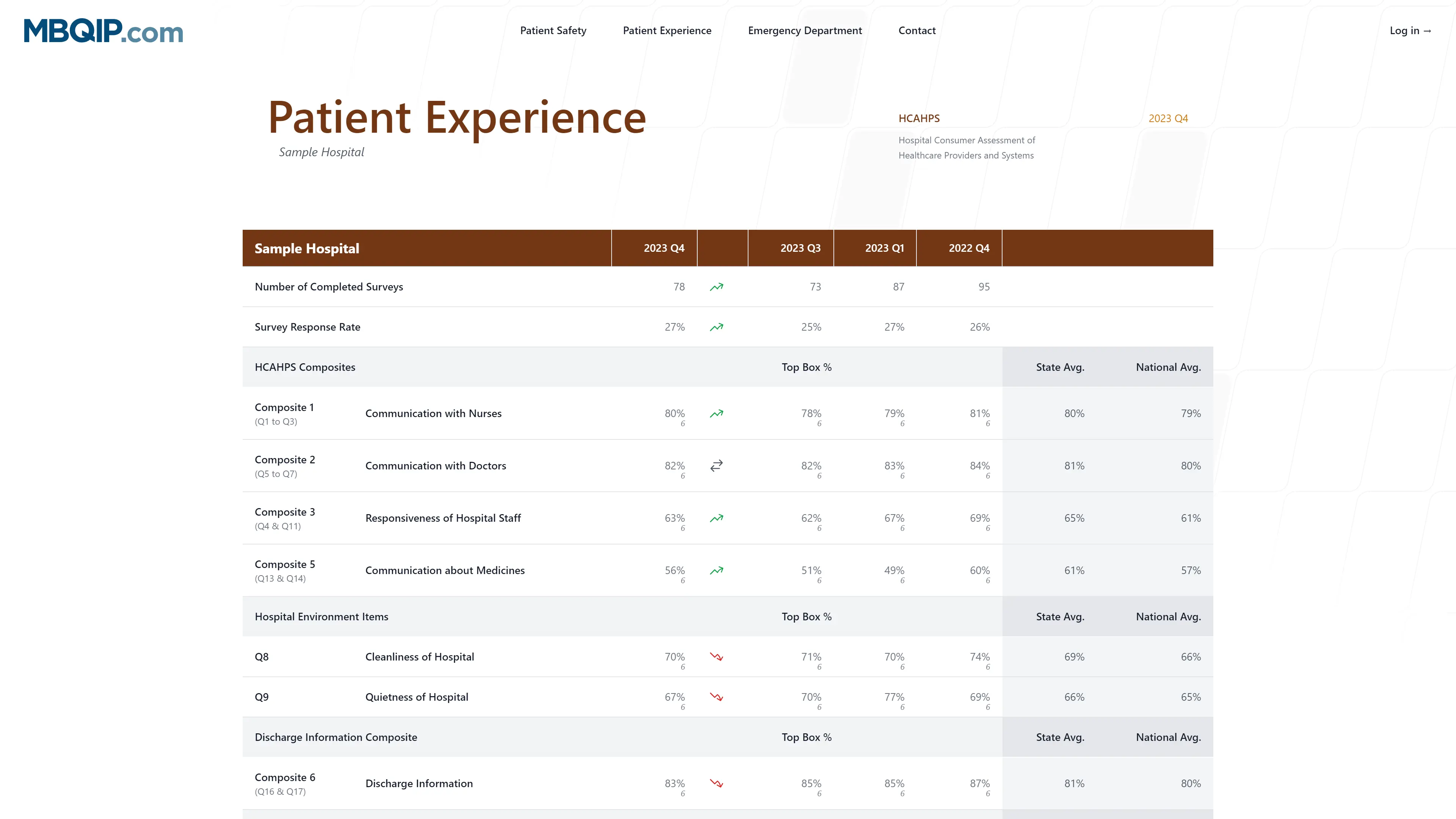Patient Experience
As we move quickly towards a healthcare system that values quality over volume of care, it is crucial to demonstrate the level of care that you are providing. With our system, we help you excel across multiple rural-relevant subject areas.
View the patient experience report of your hospital
Reports
MBQIP Patient Engagement Quality Reports summarize Hospital Consumer Assessment of Healthcare providers and Systems (HCAHPS) survey data reported by hospitals, which provides hospitals the opportunity to consider the provision of care from the patient’s point of view. In addition to four screening and seven demographic questions, the survey includes 21 questions that ask patients for their feedback on a variety of aspects related to their experience as an inpatient in the hospital. The 21 substantive questions are broken into seven composite areas, two individual topic areas, and two global topic areas. The full survey is available on the HCAHPS survey website. It is not expected that hospitals will perform at 100 percent on any individual measure because, unlike process measures, data from the HCAHPS is based on patient perception.
Using Comparison Data for HCAHPS Measures
- There is typically more variation in this type of survey data than in process measures. Therefore, you should look for trends that indicate consistent decline or improvement over time.
- Not all hospitals will be given an HCAHPS Star Rating. Hospitals must have 100 completed surveys in a rolling four quarter period to have an HCAHPS Star Rating calculated. Hospitals that usually have near 100 completed surveys in such a time period may have no Star Rating for some time periods that dip slightly below 100 completed surveys.
Note: State and national rates in the MBQIP Patient Engagement Quality Reports represent all hospitals in the state and nation, not just CAHs.

Measure Information
The areas below apply to all composites.
Encounter Periods
Q1 (January 1 – March 31)
Q2 (April 1 – June 30)
Q3 (July 1 – September 30)
Q4 (October 1 – December 31)
Submission Deadlines
Q1 encounters (January 1 – March 31) due first Wednesday in July
Q2 encounters (April 1 – June 30) due first Wednesday in October
Q3 encounters (July 1 – September 30) due first Wednesday in January
Q4 encounters (October 1 – December 31) due first Wednesday in April
Data submission deadlines on a federal holiday or weekend (Saturday or Sunday) will
default to the first business day thereafter where applicable. See MBQIP Data
Submission Deadlines.
Measure Population (Determines the cases to abstract/submit)
Patients discharged from the hospital following at least one overnight stay sometime between 48 hours and 6 weeks ago who are over the age of 18 and did not have a psychiatric principal diagnosis at discharge.
Measure Rationale
Growing research shows positive associations between patient experience and health outcomes, adherence to recommended medication and treatments, preventive care, health-care resource use, and quality and safety of care.
Sample Size Requirements
Sampling determined by HCAHPS vendor or self-administered if in compliance with program
requirements.
FORHP will be identifying an HCAHPS low volume threshold option that applies to SHIP and
Flex – threshold and timeline for implementation is forthcoming.
Data Collection Approach
Survey (typically conducted by a certified vendor)
Data Elements
Questions:
- During this hospital stay, how often did nurses treat you with courtesy and respect?
- During this hospital stay, how often did nurses listen carefully to you?
- During this hospital stay, how often did nurses explain things in a way you could understand?
Data Elements
Questions:
- During this hospital stay, how often did doctors treat you with courtesy and respect?
- During this hospital stay, how often did doctors listen carefully to you?
- During this hospital stay, how often did doctors explain things in a way you could understand?
Data Elements
Questions:
- During this hospital stay, after you pressed the call button, how often did you get help as soon as you wanted it?
- How often did you get help in getting to the bathroom or in using a bedpan as soon as you wanted?
Data Elements
Questions:
- Before giving you any new medicine, how often did hospital staff tell you what the medicine was for?
- Before giving you any new medicine, how often did hospital staff describe possible side effects in a way you could understand?
Data Elements
Question:
- During this hospital stay, how often were your room and bathroom kept clean?
Data Elements
Question:
- During this hospital stay, how often was the area around your room quiet at night?
Data Elements
Questions:
- During this hospital stay, did doctors, nurses, or other hospital staff talk with you about whether you would have the help you needed when you left the hospital?
- During this hospital stay, did you get information in writing about what symptoms or health problems to look out for after you left the hospital?
Data Elements
Questions:
- During this hospital stay, staff took my preferences and those of my family or caregiver into account in deciding what my health care needs would be when I left.
- When I left the hospital, I had a good understanding of the things I was responsible for in managing my health.
- When I left the hospital, I clearly understood the purpose for taking each of my medications.
Data Elements
Question:
- Using any number from 0 to 10, where 0 is the worst hospital possible and 10 is the best hospital possible, what number would you use to rate this hospital during your stay?
Data Elements
Question:
- Would you recommend this hospital to your friends and family?
